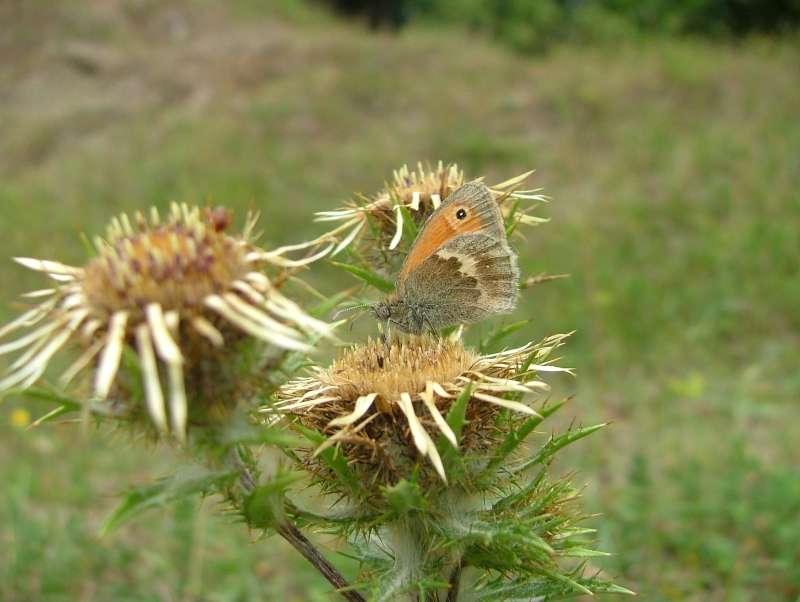
| Butterfly Conservation | |
| saving butterflies, moths and their habitats |
 |
|
|||
| North East England Branch | ||||
|
Magnesian Limestone Grasslands. The Durham Magnesian Limestone Plateau is an area of gently undulating landscape forming a roughly triangular shape with its apex at the coast in South Tyneside and its base running very approximately from Newton Aycliffe in the west to just north of Hartlepool in the east. On the western edge there is a well defined escarpment and in the east the edge of the plateau forms a more or less continuous line of pale ochre coastal cliffs. The plateau is underlain with the so-called Magnesian Limestones which are in fact a complex series of Permian dolomites and limestones that are exploited for aggregate in a number of quarries across the County. There is extensive urban and industrial development on the plateau including the major connurbation of Sunderland and many smaller towns. Although this is a densely populated and intensively used landscape, the magnesian limestone is associated with calcareous grasslands of great ecological importance in places where semi-natural habitats have been allowed to persist on land that is unsuitable for intensive cultivation. A number of sites are protected as SSSIs. Magnesian grassland is characterised by grassses such as blue moor-grass, cock's-foot, common bent, downy oat-grass, meadow oat-grass, quaking-grass, sheep's fescue, upright brome, yellow oat-grass and a variety of wildflowers. Typical flower species include Common Rock Rose, Common Bird's Foot Trefoil, Cowslip, Greater Knapweed, Carline Thistle and various orchids amongst others. 
Magnesian grassland is an important habitat for butterflies and moths. The text below first appeared in "MAGical Meadows and the Durham Magnesian Limestone" published by Durham Wildlife Trust in 2007 (ISBN 978-0-9555467-0-9) and is reproduced here with kind permission of DWT. The book can be obtained through the Durham Wildlife Trust. Examples of prime Magnesian grassland sites include Thrislington Plantation NNR, Bishop Middleham Quarry, Cassop NNR, Wingate Quarry, Castle Eden Dene NNR and Blackhall Rocks. Small Heath on Carline Thistle. Photo: J Wallace. Butterflies of the Durham Magnesian Limestone Natural Area (extract from "MAGical Meadows and the Durham Magnesian Limestone") Only 59 butterfly species are regularly recorded in the British Isles, many of which are confined to the warmer, southern counties of England. County Durham only sees just over half the British butterflies (32 since 1995), but nearly all these are encountered either regularly (20 species) or occasionally (8 species) in the Durham Magnesian Limestone Natural Area. Flower-rich chalk and limestone grasslands produce the best habitat for butterflies. The magnesian limestone grasslands of Durham are no exception. Foodplants for caterpillars and flowers for nectar are abundant. Sites on steep slopes and those with some scrub also provide the shelter loved by butterflies. Only one species, the Northern Brown Argus, a member of the blue family, is restricted to this habitat in Durham because the caterpillar foodplant, Common Rock-rose (Helianthemum nummularium) is not found elsewhere. Butterflies are what they eat, or at least what their caterpillars eat! The wide range of grasses present on magnesian limestone grassland support different butterflies, often in some abundance. The golden Small and Large Skippers both prefer quite tall grassland where their respective foodplants, Yorkshire Fog and Cock's-foot grow. The other grass feeders are all 'browns' with their distinctive eyespots including the Meadow Brown, Ringlet, Small Heath and Wall. The Small Heath prefers fine-leaved grasses like the fescues whereas a sparse sward with bare ground is more important for the Wall. The Wall is a species in serious decline in southern England, but is still abundant here. As well as the Northern Brown Argus, three other species feed on the leaves of flowers. Both the brightly coloured Common Blue and the unfortunately named Dingy Skipper feed on Common Bird's-foot-trefoil, but the latter only breeds in a short, sparse sward and is consequently scarcer. Also seen in small numbers is the beautiful Small Copper, whose caterpillars feed on sorrels. The other main groups present on the flower-rich grasslands are the 'whites' and 'vanessids'. The whites include Small, Large and Green-veined Whites and the aptly named Orange-tip. The vanessids include the familiar Red Admiral, Painted Lady, Small Tortoiseshell, Peacock and Comma, all of which you are just as likely to see nectaring on buddleias in the garden. These species are usually seen in small numbers, because their foodplants (e.g. Brassicas, nettles, thistles) are not abundant in this habitat. Moths of Magnesian Limestone Grasslands In addition to the butterflies described in the extract above, a variety of moths can also be found in magnesian limestone grasslands. Common species that can be found in day-time include Latticed Heath, Six-spot Burnet Moth, Narrow-bordered Five-spot Burnet Moth and Shaded Broad-bar. More localised and more specifically associated with limestone habitats are Cistus Forester (whose host plant is Common Rock-rose) and Chalk Carpet (a UK BAP Priority species). |
| Copyright Butterfly Conservation © 2008 North East England Branch |
| Privacy and Copyright Statement |
| Butterfly Conservation: Company limited by guarantee, registered in England (2206468) Registered Office: Manor Yard, East Lulworth, Wareham, Dorset, BH20 5QP Charity registered in England & Wales (254937) and in Scotland (SCO39268). |